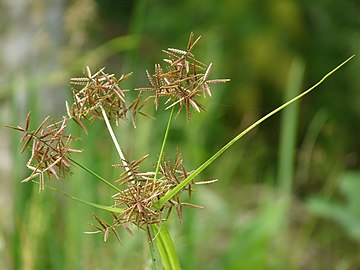Cyperaceae
The Cyperaceae (/saɪpəˈreɪsiˌaɪ, -siːˌiː/) are a family of graminoid (grass-like), monocotyledonous flowering plants known as sedges. The family is large: botanists have described some 5,500 known species in about 90 genera, the largest being the "true sedges" (genus Carex) with over 2,000 species.
| Cyperaceae | |
|---|---|
 | |
| Cyperus polystachyos flower head | |
| Scientific classification | |
| Kingdom: | Plantae |
| Clade: | Tracheophytes |
| Clade: | Angiosperms |
| Clade: | Monocots |
| Clade: | Commelinids |
| Order: | Poales |
| Family: | Cyperaceae Juss. |
| Genera | |
| 94, see text | |
Distribution
Cyperaceae species are widely distributed, with the centers of diversity for the group occurring in tropical Asia and tropical South America. While sedges grow in almost all environments, many thrive in wetlands, or in poor soils. Ecological communities dominated by sedges are known as sedgelands or as sedge meadows.
Classification
Some species superficially resemble the closely related rushes and the more distantly related grasses. Features distinguishing members of the sedge family from grasses or rushes are stems with triangular cross-sections (with occasional exceptions, a notable example being the tule which has a round cross-section) and leaves that are spirally arranged in three ranks. In comparison, grasses have alternate leaves, forming two ranks.
Some well-known sedges include the water chestnut (Eleocharis dulcis) and the papyrus sedge (Cyperus papyrus), from which the writing material papyrus was made. This family also includes cotton-grass (Eriophorum), spike-rush (Eleocharis), sawgrass (Cladium), nutsedge or nutgrass (Cyperus rotundus, a common lawn weed), and white star sedge (Rhynchospora colorata).
Features
Members of this family are characterised by the formation of dauciform (carrot-like) roots; an alteration in root morphology that researchers regard as analogous to cluster roots in Proteacea, which help uptake of nutrients such as phosphorus from poor soil.
Evolution
This section needs expansion. You can help by adding to it. (February 2024) |
Researchers have identified sedges occurring at least as early as the Eocene epoch.
Genera
As of 2024[update], 94 genera are accepted in Kew's Plants of the World Online:
- Abildgaardia Vahl
- Actinoschoenus Benth.
- Actinoscirpus (Ohwi) R.W.Haines & Lye
- Afroscirpoides García-Madr. & Muasya
- Afrotrilepis (Gilly) J.Raynal
- Ammothryon R.L.Barrett, K.L.Wilson & J.J.Bruhl
- Amphiscirpus Oteng-Yeb.
- Anthelepis R.L.Barrett, K.L.Wilson & J.J.Bruhl
- Arthrostylis R.Br.
- Becquerelia Brongn.
- Bisboeckelera Kuntze
- Blysmus Panz. ex Schult.
- × Bolboschoenoplectus Tatanov
- Bolboschoenus (Asch.) Palla
- Bulbostylis Kunth
- Calliscirpus C.N.Gilmour, J.R.Starr & Naczi
- Calyptrocarya Nees
- Capeobolus Browning
- Capitularina J.Kern
- Carex L.
- Carpha Banks & Sol. ex R.Br.
- Caustis R.Br.
- Cephalocarpus Nees
- Chamaedendron (Kük.) Larridon
- Chorizandra R.Br.
- Chrysitrix L.
- Cladium P.Browne
- Coleochloa Gilly
- Costularia C.B.Clarke
- Cryptangium Schrad. ex Nees
- Cyathochaeta Nees
- Cyathocoma Nees
- Cyperus L.
- Diplacrum R.Br.
- Diplasia Pers.
- Dracoscirpoides Muasya
- Dulichium Pers.
- Eleocharis R.Br.
- Eriophorum L.
- Erioscirpus Palla
- Evandra R.Br.
- Everardia Ridl.
- Exocarya Benth.
- Exochogyne C.B.Clarke
- Ficinia Schrad.
- Fimbristylis Vahl
- Fuirena Rottb.
- Gahnia J.R.Forst. & G.Forst.
- Gymnoschoenus Nees
- Hellmuthia Steud.
- Hypolytrum Pers.
- Isolepis R.Br.
- Khaosokia D.A.Simpson, Chayam. & J.Parn.
- Koyamaea W.W.Thomas & G.Davidse
- Krenakia S.M.Costa
- Lagenocarpus Nees
- Lepidosperma Labill.
- Lepironia Pers.
- Machaerina Vahl
- Mapania Aubl.
- Mesomelaena Nees
- Microdracoides Hua
- Morelotia Gaudich.
- Neesenbeckia Levyns
- Nelmesia Van der Veken
- Netrostylis R.L.Barrett, J.J.Bruhl & K.L.Wilson
- Oreobolus R.Br.
- Paramapania Uittien
- Phylloscirpus C.B.Clarke
- Principina Uittien
- Pseudoschoenus (C.B.Clarke) Oteng-Yeb.
- Ptilothrix K.L.Wilson
- Reedia F.Muell.
- Rhodoscirpus Léveillé-Bourret, Donadío & J.R.Starr
- Rhynchocladium T.Koyama
- Rhynchospora Vahl
- Schoenoplectiella Lye
- Schoenoplectus (Rchb.) Palla
- Schoenus L.
- Scirpodendron Zipp. ex Kurz
- Scirpoides Ség.
- Scirpus Tourn. ex L.
- Scleria P.J.Bergius
- Scleroschoenus K.L.Wilson, J.J.Bruhl & R.L.Barrett
- Sumatroscirpus Oteng-Yeb.
- Tetraria P.Beauv.
- Trachystylis S.T.Blake
- Trianoptiles Fenzl ex Endl.
- Trichophorum Pers.
- Trichoschoenus J.Raynal
- Tricostularia Nees
- Trilepis Nees
- Xyroschoenus Larridon
- Zameioscirpus Dhooge & Goetgh.
- Zulustylis Muasya
- Cyperus brevifolioides (Kyllinga gracillima)
References
External links
This article uses material from the Wikipedia English article Cyperaceae, which is released under the Creative Commons Attribution-ShareAlike 3.0 license ("CC BY-SA 3.0"); additional terms may apply (view authors). Content is available under CC BY-SA 4.0 unless otherwise noted. Images, videos and audio are available under their respective licenses.
®Wikipedia is a registered trademark of the Wiki Foundation, Inc. Wiki English (DUHOCTRUNGQUOC.VN) is an independent company and has no affiliation with Wiki Foundation.



